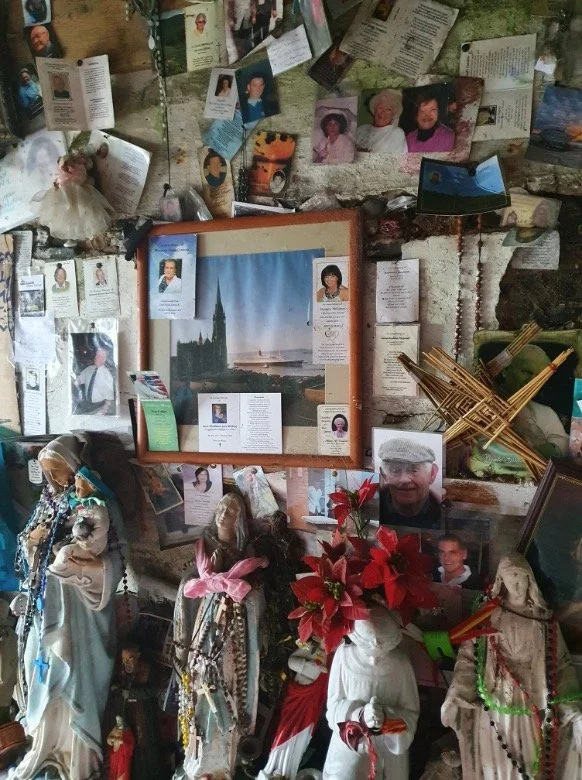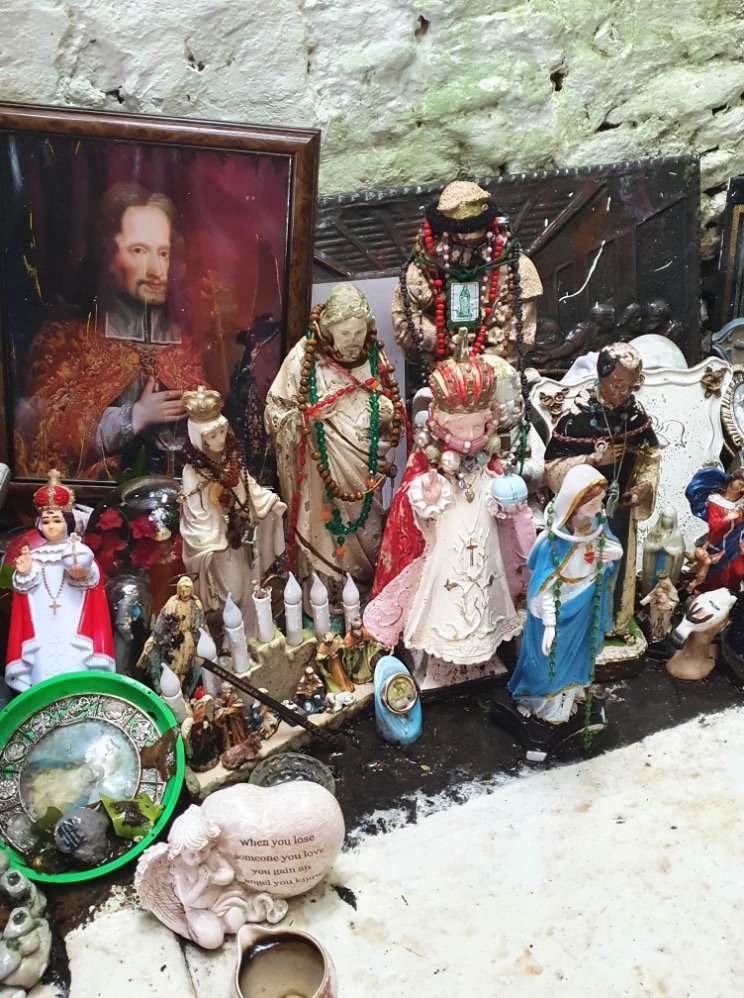St Brigid’s Well, Liscannor, County Clare, Ireland
By Emma J. McAlister
Figure 1. The Statue of St Brigid at St Brigid’s Well, Liscannor. Image: Author.
Location
St Brigid’s Well is situated in County Clare on the west coast of Ireland. The area boasts beautiful beaches, breath-taking scenery, and a UNESCO Global Geopark. It is also the location of the parochial house of the 1990s sitcom Fr Ted. For some, the well is a site of religious activity; for others, it is a place to visit on the busy tourist trail.
A brief history of Irish Holy Wells
Holy wells have been a hive of ritual activity in Ireland for centuries. Holy wells or blessed wells (Toibreacha beannaithe in the Irish language) were pagan ritual sites before being appropriated by Irish Christians. Wells are a source of water, making them historically symbolic places, as water sustains life (Ray 2014: 1). In the case of holy wells, the waters are believed to have miraculous healing qualities. As a result, holy wells are haptic spaces where people touch stones, crosses and statues and drink the water supplied by the well to avail of its remedial properties. Often sick or injured people, or those who are concerned about a loved one, will ‘take the water’ for its healing powers, whether that be bottling, touching or bathing items or hair in the water (Crawford O’Brien 2008: 328).
Between 1695 and 1778, the English Parliament imposed a series of laws on Ireland called the Penal Laws, prohibiting Mass and any Catholic worship. Holy wells (such as St Brigid’s Well) and Mass rocks were used for clandestine Mass and ritual purposes. Once the Penal Laws that prohibited Catholic worship were repealed, there was a flurry of church building across Ireland. As the institutional Irish Catholic Church gained more authority in the Nineteenth Century, worship at holy wells was side-lined.
These wells, however, are steeped in heritage and tradition. The entanglement of religion and identity is well established across Ireland, and holy wells are an example of landscapes of Irish heritage as well as lived religion. This note is concerned with the collection of votive objects that have accumulated at St Brigid’s Well and argues that the material religion displayed here provides insight into contemporary lived religion in Ireland. Furthermore, as Suzanne J. Crawford O’Brien asserts, these wells not only display ritual activity but also ‘reflect and reconstruct contemporary Irish identities’ (Crawford O’Brien 2008: 326). Additionally,the ‘towering influence’ and reputation of the Catholic Church in Ireland have been irrevocably damaged due to the abhorrent abuse of children and women by clergy, which was finally exposed in the late 1990s (Beesley 2018). While secularisation was ongoing in Ireland, these revelations accelerated what historian Crawford Gribben describes as ‘sudden onset secularization’ (Gribben 2021: 199). As a result, many people in Ireland have lost their faith, while the devotional activity at holy wells suggests that others have sustained their faith away from the institutional Catholic Church.
Figure 2. The waters at St Brigid’s Well. Image: Author.
Ritual
A text panel at the site states that this Well is ‘one of the most visited Holy Wells in Ireland’. The panel also provides visitors with guidelines for venerating St Brigid at this holy site:
The traditional rounds (prayers repeated while walking around the shrine) are as follows:
1. Standing, say
(Irish) Go mbeannai losa duit, a Bhrigid Naofa,
Go mbeannai Muire duit is go mbeannaím féin duit;
Chugat a tháinig mé ag gearán mo scéal chugat
Agus d’iarraidh cabhair in onóir De ort.
(English) May Jesus Salute you, O Holy Brigid,
May Mary Salute you and may I salute you myself.
It is to you I come making my complaint
And asking your help for the honour of God.
2. Walk around the statue five times praying. Keep the statue on your right.
3. Praying, walk the circuit up and around the steps five-times- sunwise/deiseal/clockwise.
4. Circle the cross five times and then kiss the cross.
5. Pray at the well.
Not all visitors will adhere to these guidelines, even those there for devotional reasons. Many will simply pray there, light a candle and/or leave a votive object. Those who do not follow those guidelines, but are still there to pray, will act with reverence to appease and protect the sacrality of the site. Even tourists who visit the site out of curiosity rather than piety will often behave in a restrained and quiet way when entering the cave-like area filled with offerings.
There are several stark differences in the behaviour of visitors in a museum and at a holy well. Museums can be emotionally charged spaces, but in many Western museums, visitors are not allowed to behave in ways that are against what has become museum etiquette (see Carol Duncan’s Civilising Rituals). Therefore, the votive collection at St Brigid’s Well offers a cathartic space that the traditional museum prohibits.
These offerings, the maintenance of lit candles, and the site itself emphasize that this is an active ritual site. The prayer above states, ‘it is to you I come making my complaint and asking your help for the honour of God’, which reminds us that many of the people praying and leaving offerings here are seeking help. The multitude of memorial cards left there indicate that the well is also regularly visited by grieving people to pray for deceased loved ones. The accumulated votive objects convey that this site allows for private, vulnerable and highly emotional behaviour to take place there.
Figure 3. Makeshift stone memorials at St Brigid’s Well. Image: Author.
Figure 4. A window display of St Brigid Crosses. Image: Author.
The Collection
Figure 5. The collection of ex votos at the enclave of the Well. Image: Author.
Figure 6. This image shows many memorial cards of loved ones who have passed. Image: Author.
Figure 7. A collection of ex votos, including a Brazilian flag and a slinky. Image: Author.
Figure 8. Many holy statues and a framed image of St Oliver Plunkett. Image: Author.
Figure 9. Votive objects. Image: Author.
Within the votive collection are many objects associated with the Catholic faith, such as Marian statues, Child of Prague statues, framed images of martyr St Oliver Plunkett, rosary beads, miraculous medals, crosses, Mass cards and prayer books. Also included in the votive offerings are seemingly secular objects such as teddy bears, textiles, country flags, a slinky and drawings. Although of secular origin, these objects may hold more spiritual meanings to those who left them there. For example, the object could have belonged to a deceased person, and within the context of the well, it may act as a surrogate device, connecting the living with the dead.
Figure 10. The waters of the well. There is a pregnancy test on the wall to the left. Image: Author.
One of the many attributions of St Brigid is that she is a saint of childbirth, which may be why someone had left a pregnancy test within the waters of the well. Perhaps the person who left it was giving thanks for a positive test, or perhaps they were having fertility problems and praying to St Brigid to help them conceive a child. All the objects displayed in the well are open to this kind of speculation, since no explanation for the objects left there is given.
Figure 11. Marian statues adorned with rosary beads. Image: Author.
The appearance of the Marian statues and the rituals at the well indicate that the well operates somewhat independently of the institutional Catholic Church. How the Marian statues are presented is remarkably different from how they are presented in a Catholic church. Within a church, Marian statues are kept pristine and are usually surrounded by fresh flowers. At the well, the statues look handled and appear almost strangled by the rosary beads adorning them. However, it is clear some people devotedly manage the site. There is a handwritten sign on a piece of cardboard saying ‘PLEASE DO NOT WRITE ON THE WALLS OR PAINT WORK’, and apart from a few permanent marker epitaphs, the walls are mostly clean of writing. These guidelines illustrate how certain rules are adhered to in ritual spaces to protect the supernatural presence there.
Conclusion
St Brigid’s Well illuminates ritualistic lived religion and devotional activity. The holy well is an evocative site that ‘in an era of rapid cultural change’ illustrates ’a tangible and experiential connection to Irish heritage and tradition’ (Crawford O’Brien 2008: 326). The votive objects expose human vulnerability in acute times of hardship, while the fascinating collection appeals to tourists attracted by the ephemeral curiosities inside its cave-like structure.
References
Beesley, Arthur, ‘Has Ireland lost faith in its church?’ Financial Times, 2018 (https://www.ft.com/content/20987b3c-9a97-11e8-ab77-f854c65a4465) (accessed 5 Aug. 2021)
Crawford O’Brien, Suzanne J., ‘Well, water, rock: holy wells, mass rocks and reconciling identity in the republic of Ireland’ in Material Religion: The Journal of Objects, Art and Belief, iv, no. 3 (2015), pp 326–348 (https://doi.org/10.2752/175183408X376683)
Gribben, Crawford, The Rise and Fall of Christian Ireland (Oxford, 2021)
Ray, Celeste, The Origins of Ireland’s Holy Wells (Oxford, 2014)
Emma McAlister is a Curatorial Researcher (Digital) at the National Museum of Ireland in Dublin. She is researching and cataloguing digital content related to the creation of a new permanent exhibition concerning 20th Century Irish history called ‘Changing Ireland: Stories from the Collection (1900-2020)’. This exhibition is intended to open in October 2024. She is also co-founder of the ‘Sensitive Histories Forum; which is a forum for museum staff who work closely with culturally, spiritually, and otherwise sensitive collections.
She completed her PhD thesis in 2022 entitled ‘Beyond Materiality: Religion and Ritual in Museums and Heritage Sites’ at Queen’s University Belfast. Emma is membership secretary for the Religion, Collections and Heritage Group and a member of Material and Cultural Heritage of Religion in Ireland Network. Her current academic research examines the Irish professional arts and museum sector and religious ritual behaviour in museums.










